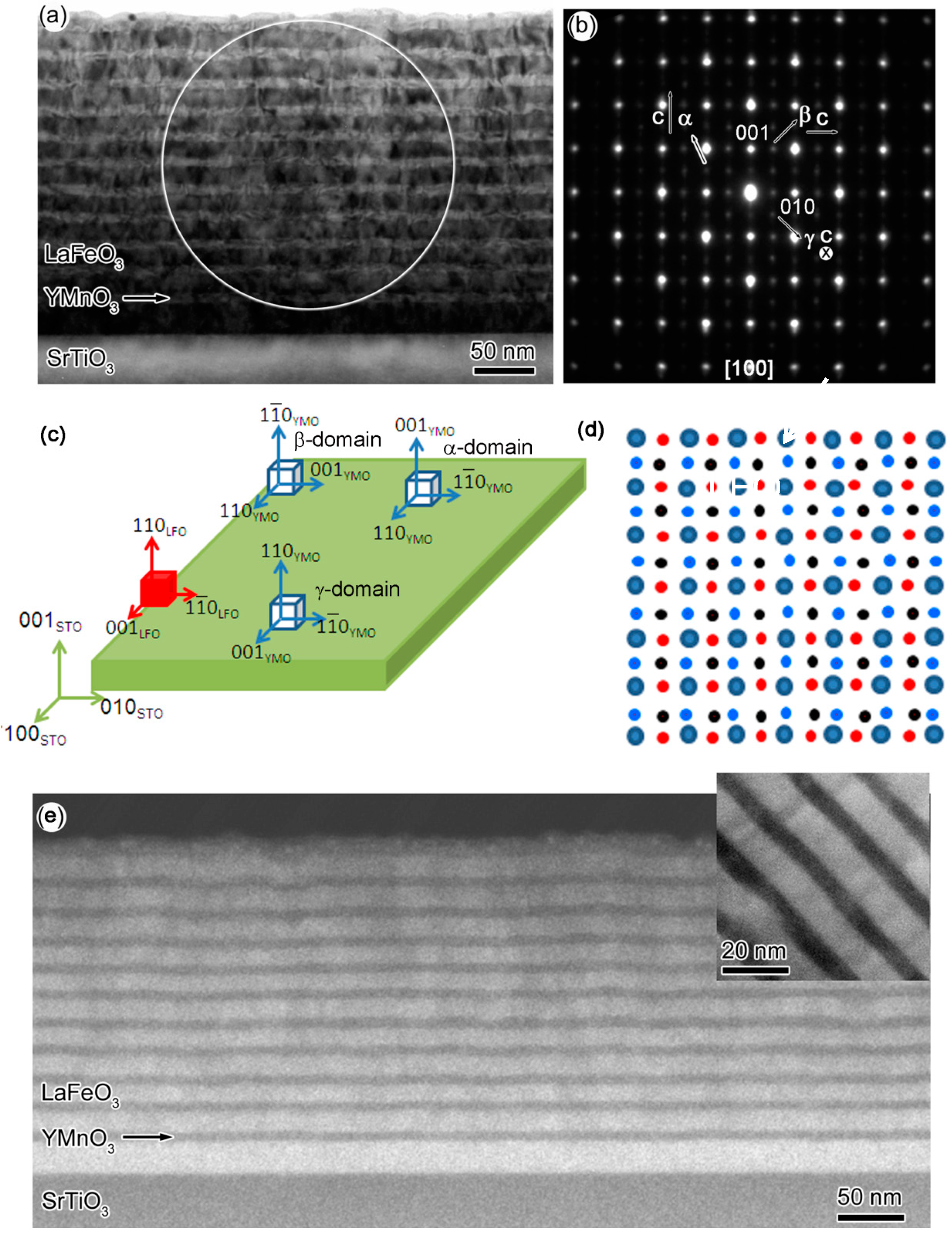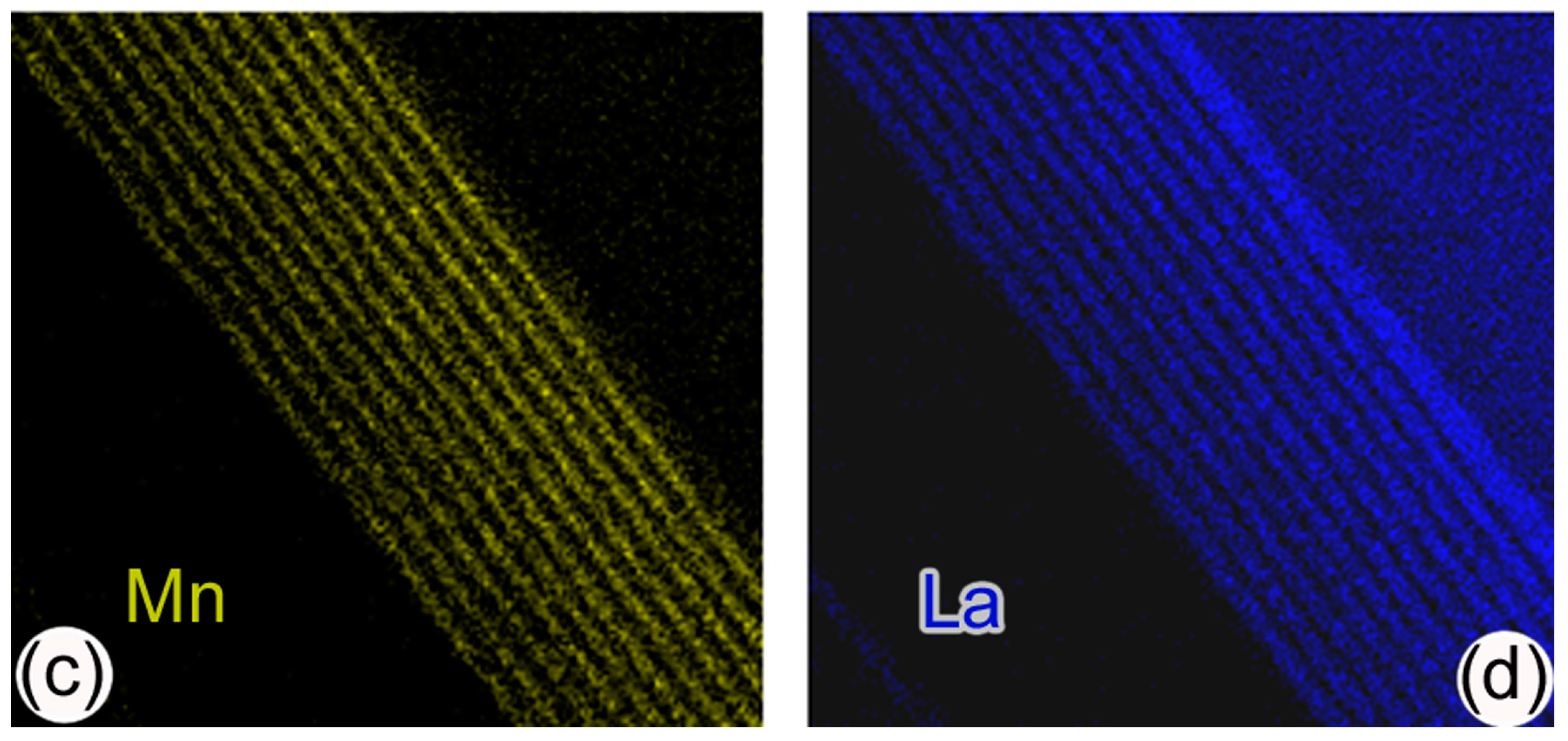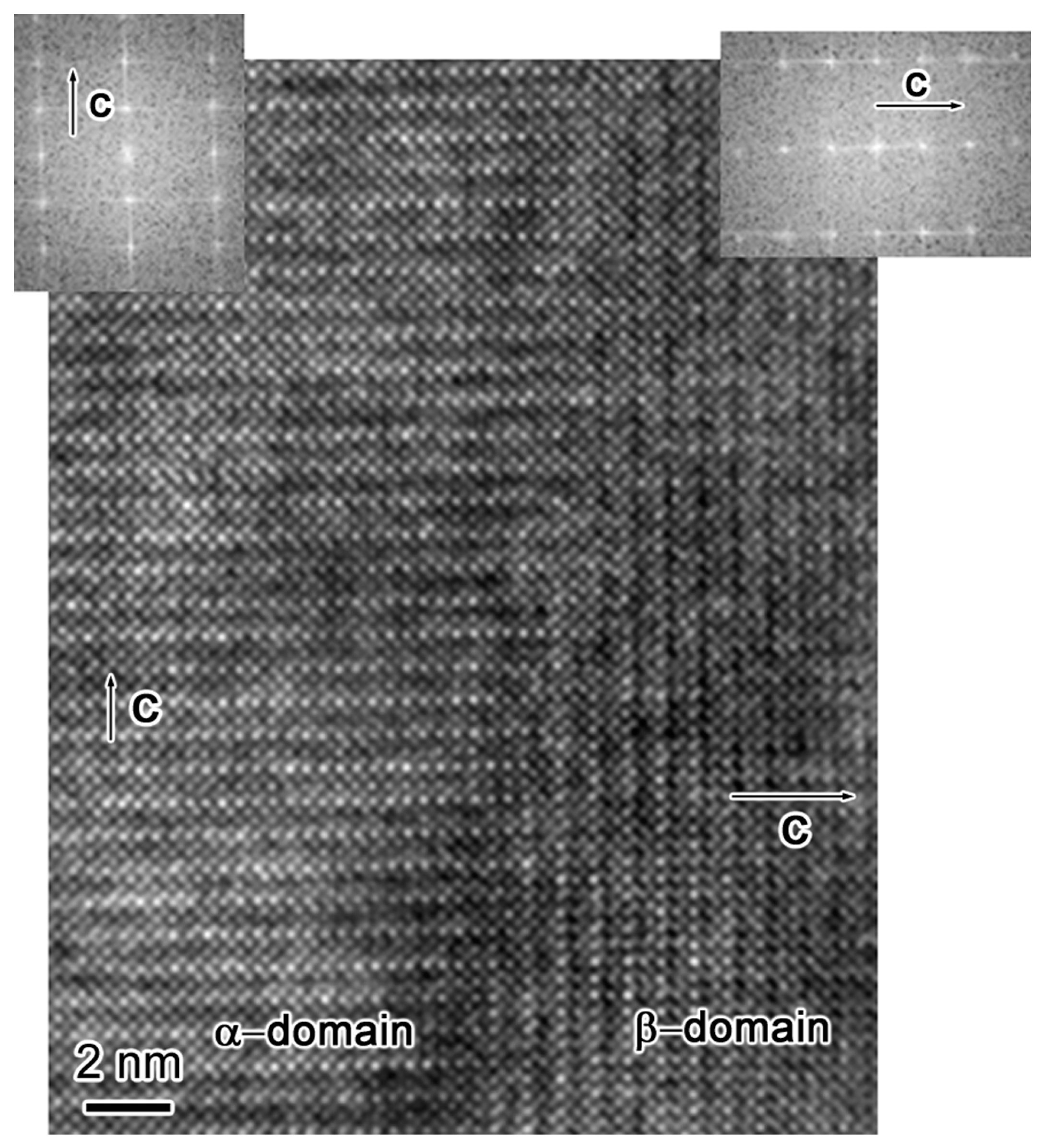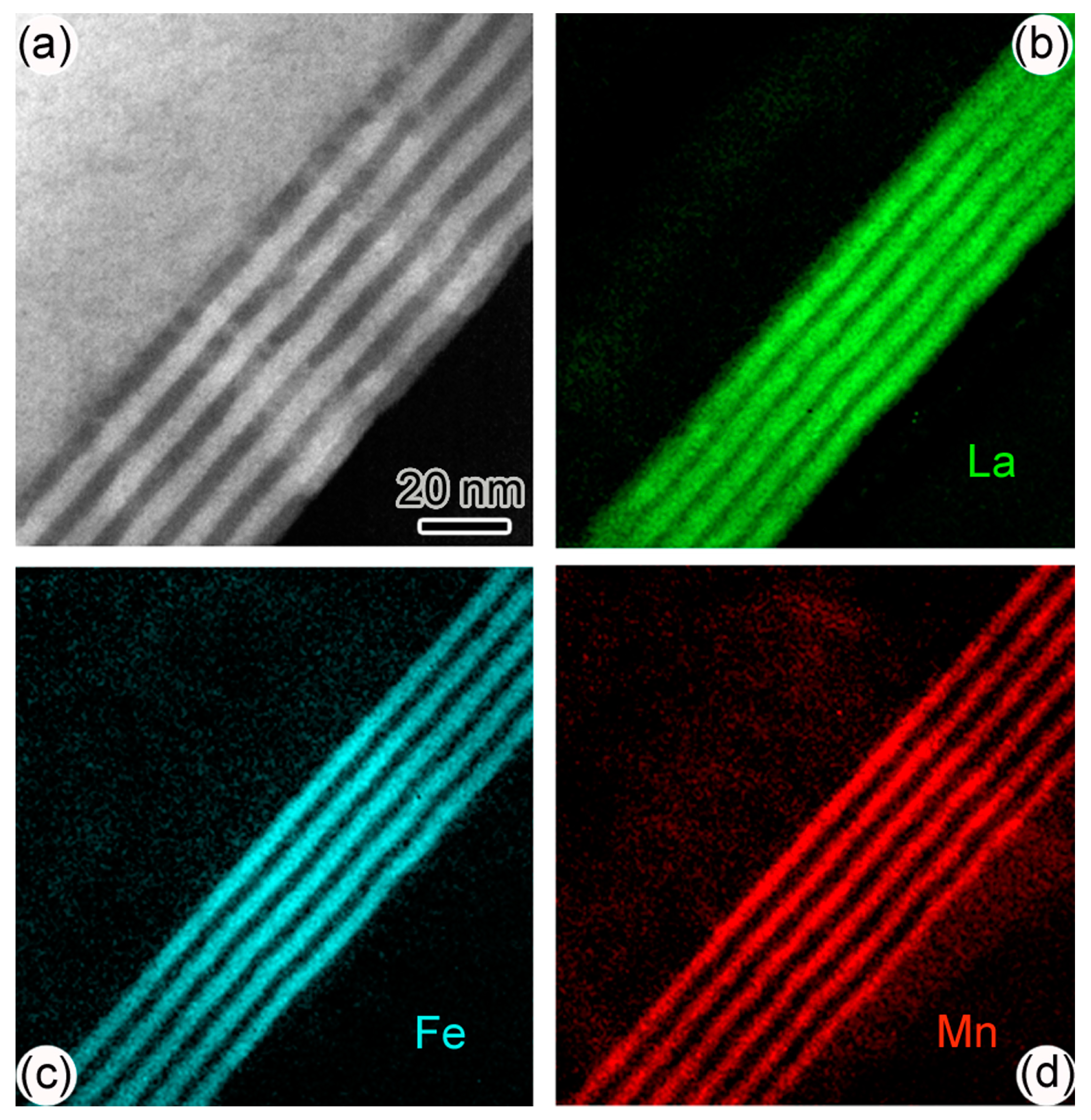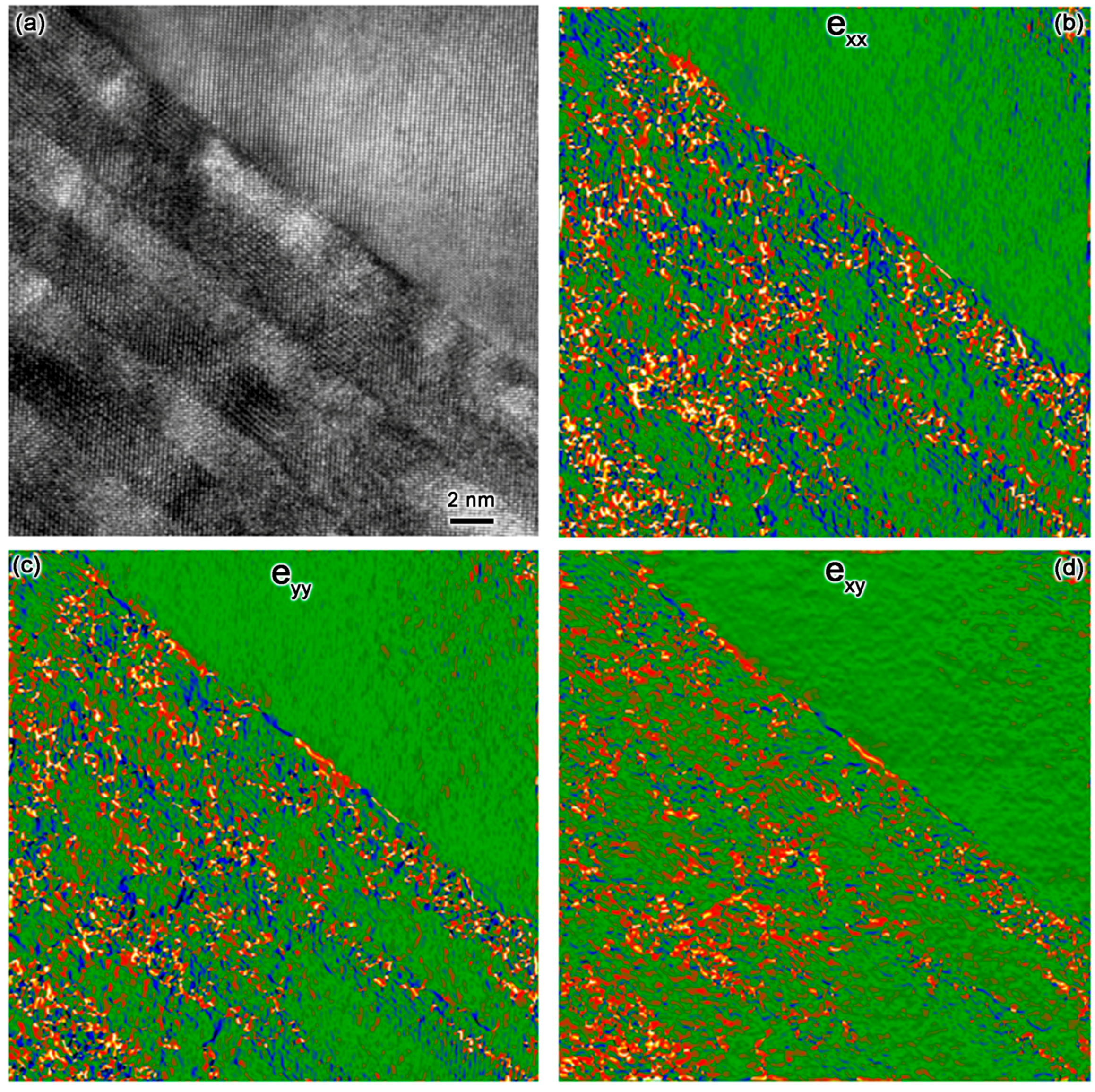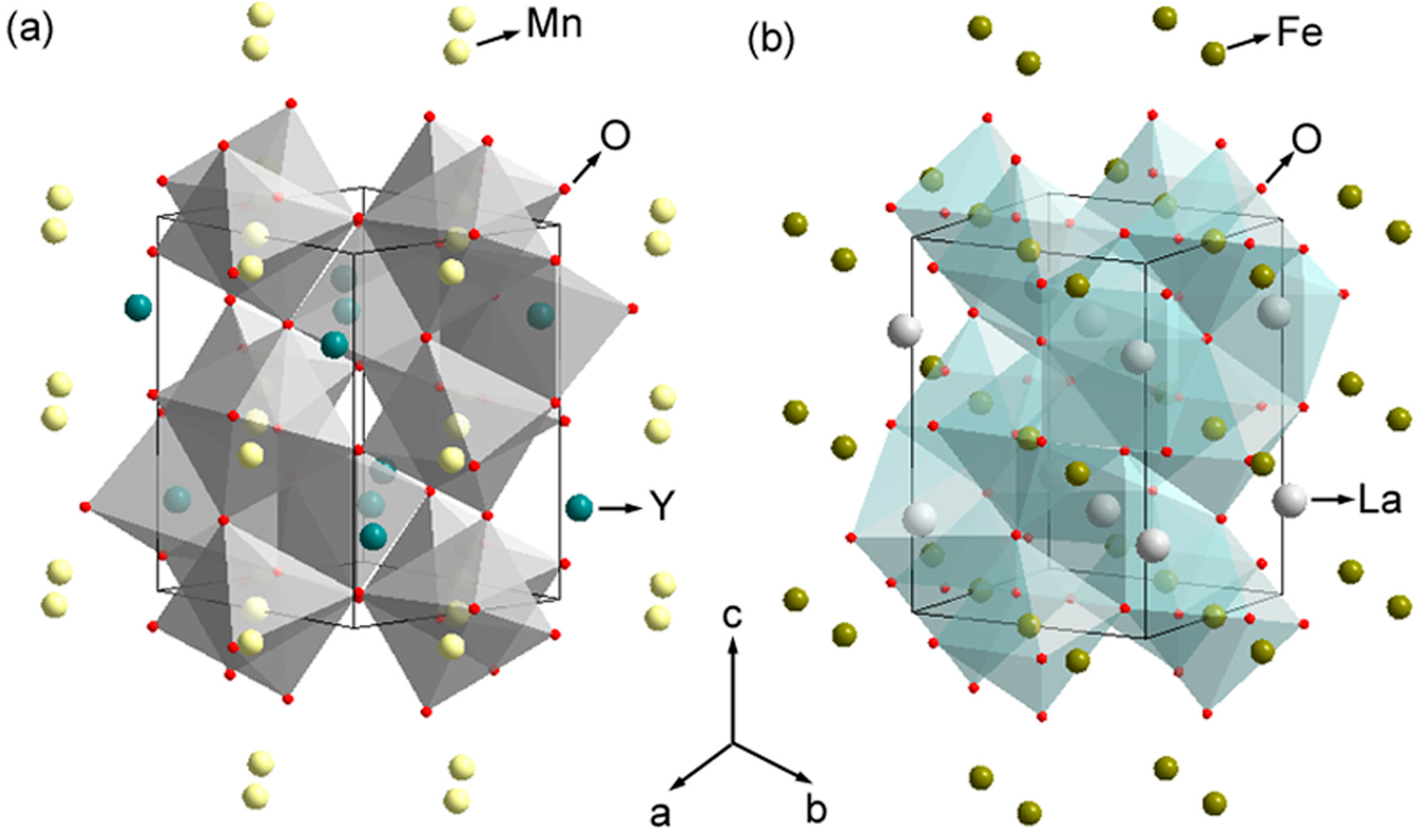1. Introduction
Transition-metal perovskite oxides with the chemical formula as ABO
3 (A and B are alkaline earth/lanthanum and transition metal elements, respectively) demonstrate the whole spectra of physical properties including metal, dielectric, ferroelectric, ferri-/ferro-/antiferro-magnetism and superconductivity [
1]. Recently, much of the scientific interest is focused on multi-functionality in single-phase/composite transition-metal pervoskites [
1]. Multi-functional materials provide the playground to explore coupling among different elementary excitations in condensed matter physics [
2,
3,
4]. A typical multifunctionality is multiferroicity [
2,
3,
4]. Though great effort has gone into this field during the past two decades, single-phase multiferroic materials are still quite rare [
5]. Stacking the multilayers composed of ferroelectric and ferromagnetic/ferrimagnetic perovskite is a feasible way to achieve the multiferroic property [
6,
7,
8]. Guided by this idea, we designed and synthesized a series of LaFeO
3-YMnO
3 (LFO-YMO) multilayers on (001)- and (111)-SrTiO
3 substrates to obtain multiferroicity [
9]. The basic consideration to choose this multilayer is that LFO is an insulating antiferromagnetic, and YMO is a weak-multiferroic, but its magnetism is E-type antiferromagnetism. Combining LFO and YMO, interfacial coupling between Mn and Fe should give rise to the strong ferrimagnetism. In this system, we do observe the co-existence of ferrimagnetism and weak ferroelectricity. The measured ferrimagnetism is attributed to antiferromagnetic coupling between Fe and Mn at the interface [
9].
The super-exchange interaction between Mn and Fe in a thin-film configuration has been studied for over two decades. Ueda, et al., firstly synthesized LaFeO
3-LaMnO
3 multilayers and studied their magnetic properties. They observed the spin-glass behavior in LaFeO
3-LaMnO
3 multilayers grown on (001)-SrTiO
3 (STO) substrate, but ferromagnetic/ferromagnetic behavior in the same multilayers on (111)-STO [
10]. In this work, they have not discussed any microstructure analysis and underlying physical origin. Quite recently, Jia et al. observed a more abstract relationship between magnetism and thicknesses of La
0.7Sr
0.3MnO
3/La
0.7Sr
0.3FeO
3 multilayers grown on (111)-STO [
11]. The same group also reported the exchange bias and anisotropic exchange interaction in La
0.7Sr
0.3MnO
3/La
0.7Sr
0.3FeO
3 multilayers grown on (111)-STO [
12]. In our previous work, one question is unsolved [
9]. The anti-ferromagnetic temperature-dependent magnetization (called spin-glass-like) is observed in LFO-YMO multilayers on (001)-STO substrate. Simultaneously, a clear ferromagnetic-hysteresis loop, with a finite residual magnetization as large as 0.3–0.5
μB, is observed in these samples. Two natural questions are: why the ferromagnetic hysteresis loop is measured in the LFO-YMO multilayer grown on (001)-STO substrate? Why does Mn-O-Fe bonding display a “spin-glass-like” behavior when multilayers are grown on (001)-STO substrates? We believe that microstructure characterization on LFO-YMO grown on both (001)- and (111)-STO can provide some hints [
13].
To fully understand the measured ferrimagnetism in LFO-YMO multilayers, it is very imperative to characterize the microstructure of LFO-YMO multilayers to answer two important questions. One is whether there is a layer-by-layer morphology in multilayers [
13]. In other words, Is the inter-diffusion between LFO and YMO layers negligible or not? The other is whether there is a multi-domain structure in the constituent layers. In the magnetic samples with a multi-domain structure, the measured ferromagnetic signals might come from the non-canceled magnetization in the multi-domain structures [
14], rather than from designed interfaces.
Taking these above-mentioned issues into consideration, we systematically characterized the microstructure of LFO-YMO multilayers grown on (001)- and (111)-STO substrates by transmission electron microscopy (TEM). Detailed TEM characterization illustrates that there is a clear layer-by-layer morphology and distinctive chemical-composition layered structure on the LFO-YMO multilayers grown on both substrates. The most noticeable feature of these multilayers is that the multilayers grown on (001)-STO substrates have three-type domain structures, but those on (111)-STO have only one. The multi-/twin- domain structure can be qualitatively explained by the lattice mismatch in this system. Based on microstructural characterizations, we think that the multi-/twin- domain structure of LFO-YMO multilayers leads to the ferromagnetic-like hysteresis loop with finite residual magnetization, rather than the interfacial Mn-Fe super-exchange interaction.
2. Results
The details of sample growth and TEM work are summarized in experimental section. In this work, three samples were characterized and they are denoted as sample-I, -II, and -III hereafter. The parameters and synthesized conditions of these samples are summarized in
Table 1.
Figure 1a shows the low-magnification TEM image of sample-I. The layer-by-layer morphology in this sample is obvious. The white and black contrast layers are YMO and LFO, respectively.
Figure 1b is the selected area electron diffraction (SAED) pattern of sample-I that was taken from the area labeled by the white circle in
Figure 1a. Apart from the major bright reflections, several weak spots, coming from the multi-domain structure of orthorhombic crystal lattices can also be observed. It should be mentioned that the weak reflection spots do not disappear when we tilted the samples off-zone axis, which rules out the possibility of double diffraction. Specifically, three weak spots, one from the [001]-, and two from the orthogonal [110]-zone axis of orthorhombic perovskite [
15], are highlighted by three white arrows. These three domains are called α-, β-, and γ-type domain hereafter. The
c-axis of α-, β-, and γ-type domains of YMO, as well as (100)-reflection from LFO are also indicated in the
Figure 1b. It should be mentioned that LFO layer is mainly composed of γ-type domain analyzed by Fast Fourier Transformation. Multi-domain structure is universally observed in orthorhombic perovskite thin films, such as PrScO
3 [
15], LaFeO
3 [
16], and SrRuO
3 [
17], etc. To elucidate the multi-domain structures in LFO-YMO more clearly, two schematics of orientation-relationships among different domains and simulated electron diffraction patterns are shown in the
Figure 1c,d. The orientation relationship between LFO and YMO in α-, β-, and γ-domain can be written as [001] (110) LFO // [110] (001) YMO, [001] (110) LFO // [110] (1
0) YMO, and [001] (110) LFO // [001] (110) YMO, respectively. The overlapped electron-diffraction pattern composed of [001] and two orthogonal [110] rotated 90° against each other is shown in
Figure 1d. Obviously, the simulated electron-diffraction pattern is the same as that in
Figure 1b.
Figure 1e and its inset are low-magnification and high-magnification high-angle-annular-dark-field (HAADF) images of sample-I, respectively, these images also show clearly layer-by-layer morphology. Apparently, LFO has much brighter contrast than YMO, which is due to the atomic number of La being much larger than that of Y [
18].
Figure 2a–d show the HAADF image, as well as energy-filtered TEM images of Fe, Mn, and La of sample-I, respectively. The element mapping images were taken using
L-peaks of Fe and Mn and
M-peak of La in electron energy loss spectrum (EELS) [
18]. It shows that the element Fe/La and Mn are distributed uniformly across the whole multilayers sample. Using EELS under STEM mode, we did observe the atomically sharp interface between YMO and LFO layers [
9].
High-resolution TEM (HRTEM) was employed to characterize the multi-domain structures in sample-I. Through our detailed study, the multi-domain structure is mainly formed in the YMO layers. Two typical HRTEM images are depicted in
Figure 3a,b. Three different areas with α-, β-, and γ-domains and their corresponding Fast Fourier Transformation (FFT) images are shown in
Figure 3, as well. Obviously, there are three types of domain structures in the YMO-layer and a composite pattern of three FFT images is the same as that in
Figure 1b. Thus, one can conclude that the multi-domain structure in the YMO layers does exist, as substantiated by both nano-scale FFT and selected area electron diffraction at the micrometer scale. The similar domain structures are also observed in PrScO
3 films [
15]. In addition, we can see from
Figure 3 that the interface between YMO and LFO is quite distinguishable.
The low-magnification TEM and HAADF image of sample-II are depicted in
Figure 4a,b, respectively. Evidently, this sample also has layered-by-layered morphology. The SAED pattern (
Figure 4c) of this sample, taken from area indicated by a white circle, also shows the feature of three-type domain structure.
The multi-domain structure of sample-II is also characterized by HRTEM. Obviously, there are two types of domain structure in
Figure 5. The left and right part (of
Figure 5) shows the α- and β-domain structure, respectively. The corresponding FFT images are inserted in
Figure 5. The c-directions of these two-type domains are labeled in
Figure 5.
Figure 6a shows the low-magnification TEM image of sample-III grown on (111)-STO substrate. Like samples I and II, the layer-by-layer morphology is observed. Here, the bright fringe is the YMO layer, and the black LFO layer.
Figure 6b is SAED pattern taken with electron aligned along [1
]-direction of STO. The area used to take SAED pattern is highlighted by a white circle. By means of SAED pattern simulation [
18],
Figure 6c shows the schematic of SAED pattern of the LFO-YMO multilayers if there are three-type of domains. Large and small black circles are reflections observed in the experiment. Blue triangles are the extra reflections if there are three types of domain.
Figure 6b,c suggest that there is only one type of domains in sample-III.
Figure 7a shows the low-magnification HAADF image of sample-III. The distinct layer structure is also observable. The bright layers are LFO and the dark ones YMO. The energy filtered TEM images of La, Fe, and Mn of sample-III are shown in
Figure 7b–d, respectively. Obviously, LFO layers are separated from the YMO layers. Therefore, it can be inferred that the inter-diffusion between LFO and YMO layers is also not serious.
A typical HRTEM image of sample-III, taken with electron-beam aligned along [11-2]-zone axis of STO, is shown in
Figure 8. Apparently, LFO and YMO have quite good lattice fringes at the nanometer scale. The interface between LFO and YMO is also quite sharp.
The average strain state of LFO-YMO multilayers (sample-III) is studied by geometric-phase-analysis [
19] and the results are depicted at
Figure 9. Obviously, there are substantial strain e
xx, e
yy, and e
xy. (e
xx and e
yy are pure strain along the
x and
y axes, while e
xy is a torsional strain [
19]) in LFO-YMO multilayers. Accordingly, there is strong stress and resultant crystal defects in the LFO-YMO multilayers grown on (111)-STO substrate. This suggests that though there is only single-domain structure, strain relaxation and resultant crystal defects in sample III are universally existed. The reason for strain state is discussed below.
3. Discussion
We would like to qualitatively explain the formation of multi-domain structures in YMO-LFO multilayers grown on (001)-STO substrate from the viewpoint of mechanical strain. The lattice constants of orthorhombic LFO are:
a = 5.556 Å,
b = 5.565 Å, and
c = 7.862 Å [
20], and those of orthorhombic YMO are:
a = 5.836 Å,
b = 5.258 Å, and
c = 7.357 Å [
21]. STO has a simple cubic structure,
a = 3.91 Å. It is noticed that
a and
b of LFO are quite close, but those of YMO are not; they are quite different. For the sake of simplicity, the orthorhombic perovskite can be viewed as pseudo-cubic structure. LFO can be treated as
aP = 3.93 Å, while in YMO,
aP =
bP = 3.91 Å, and
cP = 3.68 Å. In other words, LFO is closer to a cubic structure, but YMO is closer to a tetragonal one. Theoretically, the multi-domain structure is related to the relaxation of the mechanical strain among YMO, LFO, and STO [
22,
23]. SAED results (
Figure 1b,c) prove that the in-plane orientation relationship between LFO and YMO are: [001]-[1-10]LFO // [110]-[1-10] YMO, [001]-[1-10]LFO // [110]-[001] YMO and [001]-[1-10]LFO // [001]-[1-10] YMOin the α-, β-, and γ-domain configurations, respectively. The in-plane lattice mismatch
ε is defined as
[
24] where
a1,2 is the lattice constant of component layer 1 and 2 in the pseudo-cubic setting. Accordingly, the in-plane theoretical
ε between STO and YMO (LFO), as well as YMO and LFO can be calculated and summarized in
Table 2. Evidently, lattice mismatch
ε between YMO and STO, LFO and YMO, can be as large as 6%. Theoretically, the large mismatch can be relaxed by the formation of crystal defects, such as domain structure, dislocations, and grain-boundaries. If we only consider the lattice mismatch between LFO and YMO, generation of α-domain should be dominated to minimize the strain energy of this system [
22,
23]. But it should be mentioned that in LFO-YMO multilayers, the YMO lattice has much more distorted oxygen octahedra than LFO (see
Figure 10) [
20,
21]. In this case,
torsional torque should be considered, too [
22,
23]. Thus, the multi-domain structure might be formed to relax the torsional strain besides shear strain [
23], which has been discussed in the formation of multi-domain structures in ferroelectric thin films. This leads to the observation of the multi-domain structure in YMO-LFO multilayers grown on (001)-STO substrate. It should be mentioned that the existence of pure- and torsional-strain in YMO-LFO multilayers has been revealed by geometric-phase-analysis (see
Figure 9).
When the substrate is changed to (111)-STO, the corresponding in-plane lattice mismatch
ε in this system is outlined in
Table 3. Apparently, the lattice mismatches between component layers are smaller than 3.5%, which is smaller than that in (001)-STO substrate. This may be the reason that there is only one type of domain when the substrate is (111)-STO.
Certainly, the above-discussion is qualitative. A quantitative method, like the first-principles calculation of formation energy in the different domain structures [
25], should be applied to further explore the physical origin of the multi-domain formation.
Finally, it is valuable to mention that the above-mentioned domain structure characterization is very central to explaining the measured magnetic properties. Based on the above-mentioned microstructure analysis, the magnetic property of YMO-LFO multilayer grown on (111)-STO can be attributed to the ferrimagnetism generated at interface between YMO and LFO, since there is only a single domain. However, the ferromagnetic hysteresis loop measured in YMO-LFO multilayer grown on (001)-STO should be attributed to non-canceled multi-/twin-domain structure, rather than the designed interfaces. It has been reported that YMO films with multi-/twin-domain structures show the clear ferromagnetic hysteresis loop though YMO is an antiferromagnetic compound [
26]. Considering the universal existence of multi-domain structure in perovskite thin films grown on (001)-substrates, the spin-glass behavior observed in the LaFeO
3-LaMnO
3 multilayer grown on (001)-STO substrate [
10] may also come from the multi-domain structure.
